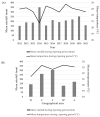Multi-Mycotoxin Long-Term Monitoring Survey on North-Italian Maize over an 11-Year Period (2011-2021): The Co-Occurrence of Regulated, Masked and Emerging Mycotoxins and Fungal Metabolites
- PMID: 36006184
- PMCID: PMC9416020
- DOI: 10.3390/toxins14080520
Multi-Mycotoxin Long-Term Monitoring Survey on North-Italian Maize over an 11-Year Period (2011-2021): The Co-Occurrence of Regulated, Masked and Emerging Mycotoxins and Fungal Metabolites
Abstract
Maize is considered one of the most susceptible crops to mycotoxin-producing fungi throughout the world, mainly belonging to the Fusarium spp. and Aspergillus spp. Maize is mainly used as animal feeds in Italy, as well as for human consumption, being essential for all the protected designation of origin (DOP) products. Our study investigated the occurrence of regulated mycotoxins in 3769 maize grain samples collected from 88 storage centers by the National Monitoring Network over an 11-year period (2011-2021). Moreover, an in-depth survey over a 4-year period, characterized by extremely different meteorological conditions, was conducted to investigate the co-occurrence of regulated, masked, and emerging mycotoxins. The survey confirmed that Fusarium spp. was the most frequent fungi and fumonisins were the main mycotoxins that were constantly detected in the different years and areas. Moreover, the areas characterized by high fumonisin levels were also the most prone to contamination by emerging mycotoxins produced by the same Fusarium species of the Liseola section. On the other hand, as a result of climatic changes, maize grains have also been affected by the increased frequency of aflatoxin accumulation. Deoxynivalenol, zearalenone, and other emerging mycotoxins produced by the same Fusarium species as the Discolor section occurred more abundantly in some areas in Northern Italy and in years characterized by predisposing meteorological conditions.
Keywords: Aspergillus; Fusarium; aflatoxin B1; deoxynivalenol; fumonisins; survey; zearalenone.
Conflict of interest statement
The authors declare no conflict of interest.
Figures











References
-
- Munkvold G.P., Arias S., Taschl I., Gruber-Dorninger C. Mycotoxins in corn: Occurrence, impacts, and management. In: Serna-Saldivar S.O., editor. Corn: Chemistry and Technology. 3rd ed. AACC International Press; Washington, DC, USA: 2019. pp. 235–287. - DOI
-
- European Commission Commission Regulation (EC) 1126/2007 of the European Parliament and of the Council of 28 September 2007 amending Regulation (EC) No 1881/2006 setting maximum levels for certain contaminants in foodstuffs as regards Fusarium toxins in maize and maize products. Off. J. Eur. Union. 2007;L255:14–17.
-
- European Commission Commission Regulation (EC) No 165/2010 of 26 February 2010 amending Regulation (EC) No 1881/2006 setting maximum levels for certain contaminants in foodstuffs as regards aflatoxins. Off. J. Eur. Union. 2010;L50:8–12.
-
- European Commission Directive 2002/32/EC of the European Parliament and of the Council of 7 May 2002 on undesirable substances in animal feed. Off. J. Eur. Union. 2002;L140:10–22.
Publication types
MeSH terms
Substances
LinkOut - more resources
Full Text Sources
Miscellaneous

